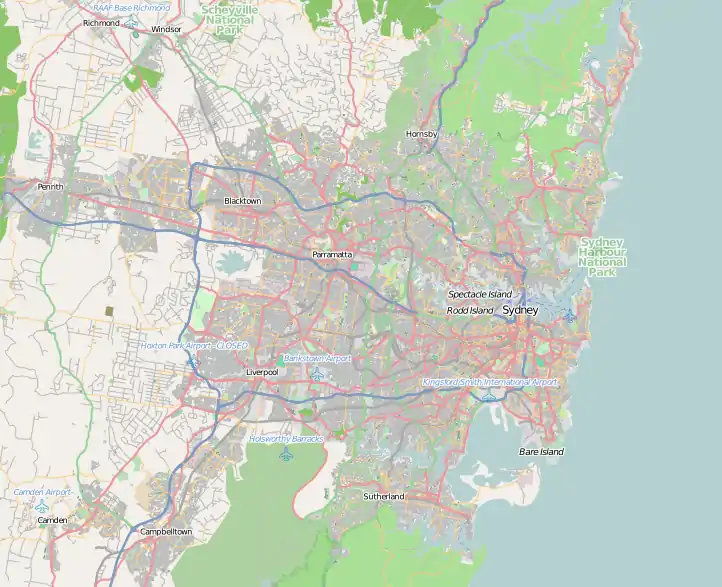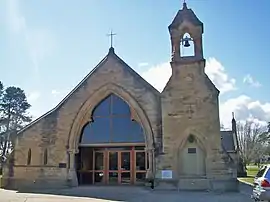Cemetery Station No. 1 | |
|---|---|
 Haslem's Creek Cemetery station c. 1865 | |
| General information | |
| Other names |
|
| Location | Rookwood Cemetery, Rookwood, Sydney, New South Wales Australia |
| Coordinates | 33°52′11″S 151°03′04″E / 33.869683°S 151.051245°E |
| Line(s) | Rookwood |
| Distance | 17.546 kilometres (10.903 mi) from Central |
| Platforms | 1 |
| Tracks | 1 |
| Construction | |
| Structure type | At grade |
| Other information | |
| Status |
|
| History | |
| Opened | 1 April 1867 |
| Closed | 29 December 1948 |
| Location | |
 Cemetery Station No. 1 Location of the site remnants in greater metropolitan Sydney | |
The Cemetery Station No. 1[1] was a railway station on the Rookwood Cemetery railway line in Sydney, New South Wales, Australia. The station operated between 1867 and 1948 and served the Rookwood Cemetery. The building was designed by NSW Government Architect James Barnet.
History
The Cemetery No. 1 railway station (also known as No. 1 Mortuary Receiving Railway Station) was on the Rookwood Cemetery railway line. It was decided that funeral processions could be more dignified (and easier) if more official stations were created to replace the ones with original corrugated iron and timber structures. A scheme set up to separate funeral operations from the ordinary railway by the establishment of new platforms began in 1868 with the building of the Cemetery station inside the Necropolis.[2]
The station opened as Haslem's Creek Cemetery Station on 1 April 1867. Some time before 1872, the station name was changed to Necropolis. The station was called Mortuary Terminus before having its name changed to Mortuary General Cemetery on 26 July 1897, when its name was transferred to the new terminus (later Cemetery Station No. 3 railway station). Finally the name was changed to Cemetery Station No. 1 on 15 June 1908, and it closed on 29 December 1948.[1]
The sandstone station building included wide platforms, a ticket office, two vestibules, retiring rooms and a carriage port.[3] This building was elaborately decorated in a similar style to Regent Street railway station in Redfern. The work of sculptors Thomas Ducket and Henry Apperly and carvers Moxon and Apperly SMH (Thursday 9 April 1868 p5), included angels, cherubs, gargoyles and various foliage carvings featuring flowers, pears, sycamores, apples and pomegranates.[3] Black and white floor tiles created by Cumberland pottery were laid in a tessellated pattern on the floors.[2]
The building spanned the terminus of the railway line into the cemetery so it created a tunnel effect. It covered an area of 35 by 13 metres (115 ft × 43 ft) and was approximately 6 metres (20 ft) high, being carried on 12 columns. An arch at each end of the building was approximately 12 metres (39 ft) high and 13 metres (43 ft) wide at the base.[4] The northern arch was decorated with two angels opposite each other on the inner side of the arches. One angel appeared to be holding a scroll (which may have been the Judgement book) and its eyes were closed. The other angel was set to look down the railway line and held a trumpet in its hands, which probably symbolised the resurrection of the dead.[4] The building had a bell-cote for housing a bell that was used during the funeral services. The bell was tolled to warn passengers of the impending departure time. It is believed (but not verified) that the bell would ring as each train arrived, and between 1910 and 1920 the bell was rung 30 minutes before the train was to depart to warn the passengers.[4] It rang again when there was five minutes left to departure.[2]
The station was an ornate stone building. After closure the station building was dismantled and moved to Canberra in 1958, where it is now All Saints Church. The rebuilt church contains some modifications, the most obvious of which is the change in position of the bell tower to the opposite side.[5]
Restoration
In the middle of 2000, work began to improve the station site (at Rookwood Cemetery) and to restore the original pathways. The restoration work included exposing the gutters, uncovering the foundations of the platform (located at 33°52'10.86"S 151° 3'4.48"E), indicating the former locations of the structural columns and re-gravelling the pathways.[6] A signpost at the site indicates the name for the station as being No. 1 Mortuary Receiving Station and states that building work commenced on 14 April 1867, and was completed 10 August 1869.
Gallery
 Site remnants, pictured in July 2019
Site remnants, pictured in July 2019 Site remnants, pictured in July 2019
Site remnants, pictured in July 2019 Signpost at site, July 2019
Signpost at site, July 2019 Site remnants, pictured in July 2019
Site remnants, pictured in July 2019 Site remnants, pictured in July 2019
Site remnants, pictured in July 2019 Site remnants, pictured in July 2019
Site remnants, pictured in July 2019 Site remnants, pictured in July 2019
Site remnants, pictured in July 2019 Plaque at site, July 2019
Plaque at site, July 2019 The station building, now All Saints Church in Canberra
The station building, now All Saints Church in Canberra
See also
References
- 1 2 State Rail Authority of New South Wales Archives Section (1982). How & Why of Station Names: meanings and origins... (2nd ed.). State Rail Authority of New South Wales.
- 1 2 3 Ochert, M. S. (1998). "The Mortuary Station to Rookwood". Locality. 9 (2): 23–26.
- 1 2 Buckle, E. G. (1987). A station of the cross: All Saints Anglican Church, Ainslie, Canberra, The Church.
- 1 2 3 Singleton, C. C. (1989). The Rookwood Cemetery Line in The Sleeping City: The Story of Rookwood. New South Wales: Society of Australian Genealogists.
- ↑ "Heritage". All Saint's Church Ainslie. Archived from the original on 3 May 2006.
- ↑ A Rookwood Ramble: A short self guided walking tour. New South Wales: Friends of Rookwood. 2002.
Neighbouring stations
| Preceding station | Former Services | Following station | ||
|---|---|---|---|---|
| Cemetery Station No. 2 towards Cemetery Station No. 4 |
Rookwood Cemetery railway line | Regent Street Terminus | ||